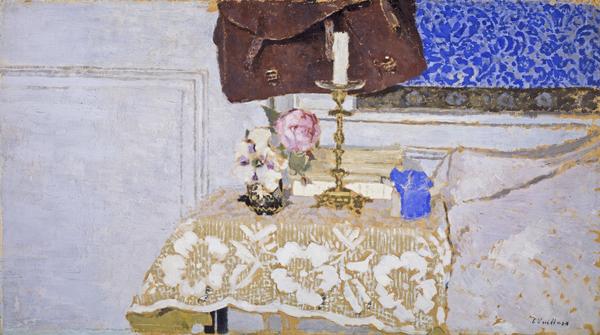
Édouard Vuillard (1868-1940) is a painter one doesn’t hear much (enough?) about. The Holburne Museum in Bath has an extensive exhibition, open until September 15th, which shows why we should pay more attention to him. The title caught my eye: we describe things as ‘poetic’ without thinking too much about why we are paralleling them with a different art. Here, the title is taken from Vuillard’s comment that ‘Who speaks of art speaks of poetry. There is no art without a poetic aim.’ Does this mean that art – any art – tells a story? That it has formal structures, decorative devices which mimic rhetoric, that it speaks to us? Perhaps. These things seemed clearer to me after exploring Vuillard’s early works in this exhibition.

Coming after the Impressionists, Vuillard was interested in decorative arts, also working in theatres, for example, and this is very clear in his interiors, where the decoration is given similar prominence to the people, which reminds me of the Pre-Raphaelite focus on nature, and the consequent apparent alignment of the figures with the natural world. Vuillard’s constructed backdrops thus suggest that his characters – for they do feel like characters, in a play or a novel, perhaps – are equally constructed, created, made up, even. Staged. He paints a lot of women, placed in domestic situations and with expressions on their faces which can be very telling. For example, in Woman Reading in the Reeds (1909), the woman, absorbed in her book, seems almost to be hiding, intent on finding a quiet corner away from her family and domesticity to focus on her novel. Are his women trapped, or bored, I wonder? Child in a White Smock (1910) might represent a powerful mother and child bond, but the mother looks indulgently but also rather languidly at the child, with an ambiguous expression familiar to most mothers of young children, however devoted.

This is interesting, then: Vuillard does not seem, to me, to paint women so much as to attempt to give a female perspective. Painting interiors (and particularly ones such as The Open Window (1902-15), which seem to provide a means of escape, of flight and freedom), takes a woman’s situation and explores it, looking at the psychological effects of confinement which are heightened by the attention to detail and decoration. Often a painting takes an unusual angle or approach, suggesting a slantwise approach to the poetics of domesticity, perhaps. Women’s faces are often obscured, even when they face the viewer, though they are also often turned away. Instead of reading their eyes and expressions, we must read the shapes their bodies make, the way others react to them, the patterns of the wallpaper and the arrangement of domestic objects. And where we do get a clear view of her face, such as the pleasant expression on the face of Madame Hessel on a Sofa (1905), we are misled: she is not, the label tells me, particularly pleasant and open. Other works, such as The Artist’s Sister with a Cup of Coffee (1903), show a woman whose face is half in shadow, or Madame V Arranging her Hair (1900) which with the side-view of the figure suggests, as the label outlines, a ‘sense of candid observation’ – and here it seems a more traditional approach to masculine paintings of women, for although we feel included in the domestic scene we are voyeurs, watching rather than sympathising with the female figure.

Not all paintings include figures. The Candlestick (1900) offers an intimate and decorative portrait of a domestic object, a painting where there is both rigour and informality, mimicking the still lives of earlier artists but with a slightly untidy, genial approach which finds a different ‘beauty in everyday details’. Nearly all the works here are small, and depict highly decorated, busy interiors crammed into their decorative frames, giving a feeling of claustrophobia and richness. This effect is slightly restrained by the muted tonal colours Vuillard tends to use, however. There is a sense of closeting, then, throughout most of the paintings here, and apparent informality is underpinned by a deeper structure of design and decoration. Some paintings zoom in on a tiny detail while other shows a much wider scene; the effect of this, as you go round the exhibition hall, is disorientating – and art (like poetry) should disorientate, forcing us to readdress our ideas of scope and scale, of what is significant but too easily overlooked.


Leave a comment